Comprehensive Performance Evaluation of Green Infrastructure Practices for Urban Watersheds Using an Engineering–Environmental–Economic (3E) Model
Abstract
:1. Introduction
2. Materials and Methods
2.1. Study Area
2.2. Framework for Determining the BAGI Practices
2.3. Performance Evaluation of the Green Infrastructure Practices
2.4. Establishment of the 3E Triangle Model
2.5. Cost–Benefit Analysis of the Implementation of Green Infrastructure: A Case Study of the Pearl River Delta
3. Results and Discussion
3.1. Engineering Performance of the Selected Available Green Infrastructure Practices
3.2. Life Cycle Assessment of the Selected Available Green Infrastructure Practices
3.3. Evaluation of the Selected Best Available Green Infrastructure Practices of the 3E Model
3.4. Preliminary Cost–Benefit Results of Implementation of Green Infrastructure in the Pearl River Delta
4. Conclusions
Author Contributions
Funding
Institutional Review Board Statement
Informed Consent Statement
Data Availability Statement
Acknowledgments
Conflicts of Interest
References
- Naiman, R. (Ed.) New Perspectives for Watershed Management: Balancing Long-Term Sustainability with Cumulative Environmental Change. In Watershed Management: Balancing Sustainability and Environmental Change; Springer: New York, NY, USA, 1992; pp. 3–11. [Google Scholar]
- Dowd, B.M.; Press, D.; Los Huertos, M. Agricultural nonpoint source water pollution policy: The case of California’s Central Coast. Agric. Ecosyst. Environ. 2008, 128, 151–161. [Google Scholar] [CrossRef]
- Thacker, S.; Adshead, D.; Fay, M.; Hallegatte, S.; Harvey, M.; Meller, H.; O’Regan, N.; Rozenberg, J.; Watkins, G.; Hall, J.W. Infrastructure for sustainable development. Nat. Sustain. 2019, 2, 324–331. [Google Scholar] [CrossRef]
- Reimer, A. U.S. Water Policy: Trends and Future Directions; National Agricultural and Rural Development Policy Center: State College, PA, USA, 2012. [Google Scholar]
- Benedict, M.A.; McMahon, E.T. Green infrastructure: Smart Conservation for the 21st Century. Renew. Resour. J. 2002, 20, 12–17. [Google Scholar]
- Buckley, M. Economic Benefits of Green Infrastructure: Chesapeake Bay Region; ECONorthwest: Portland, OR, USA, 2011. [Google Scholar]
- Bhaskar, A.S.; Hogan, D.M.; Archfield, S.A. Urban base flow with low impact development. Hydrol. Process. 2016, 30, 3156–3171. [Google Scholar] [CrossRef] [Green Version]
- Risch, E.; Gasperi, J.; Gromaire, M.-C.; Chebbo, G.; Azimi, S.; Rocher, V.; Roux, P.; Rosenbaum, R.K.; Sinfort, C. Impacts from urban water systems on receiving waters–how to account for severe wet-weather events in LCA? Water Res. 2018, 128, 412–423. [Google Scholar] [CrossRef]
- United States Environmental Protection Agency. What is Green Infrastructure? United States Environmental Protection Agency. 2016. Available online: https://www.epa.gov/green-infrastructure/what-green-infrastructure (accessed on 6 April 2020).
- Woods Ballard, B.; Wilson, S.; Udale-Clarke, H.; Illman, S.; Scott, T.; Ashley, R.; Kellagher, R. The SuDS Manual. CIRIA. 2015. Available online: https://www.susdrain.org/resources/SuDS_Manual.html (accessed on 6 April 2020).
- Torre, A.; Monk, E.; Chalmers, L.; Spencer, R. Stormwater Management Manual for Western Australia. Department of Water, Government of Western Australia, 2006. Available online: https://www.water.wa.gov.au/urban-water/urban-development/stormwater/stormwater-management-manual (accessed on 29 February 2020).
- Yang, B.; Li, S. Green Infrastructure Design for Stormwater Runoff and Water Quality: Empirical Evidence from Large Watershed-Scale Community Developments. Water 2013, 5, 2038–2057. [Google Scholar] [CrossRef]
- Vineyard, D.; Ingwersen, W.W.; Hawkins, T.R.; Xue, X.; Demeke, B.; Shuster, W. Comparing Green and Grey Infrastructure Using Life Cycle Cost and Environmental Impact: A Rain Garden Case Study in Cincinnati, OH. JAWRA J. Am. Water Resour. Assoc. 2015, 51, 1342–1360. [Google Scholar] [CrossRef]
- Flynn, K.M.; Traver, R.G. Green infrastructure life cycle assessment: A bio-infiltration case study. Ecol. Eng. 2013, 55, 9–22. [Google Scholar] [CrossRef]
- Wang, R.; Eckelman, M.J.; Zimmerman, J.B. Consequential Environmental and Economic Life Cycle Assessment of Green and Gray Stormwater Infrastructures for Combined Sewer Systems. Environ. Sci. Technol. 2013, 47, 11189–11198. [Google Scholar] [CrossRef] [PubMed]
- Davies, Z.G.; Fuller, R.A.; Loram, A.; Irvine, K.N.; Sims, V.; Gaston, K.J. A national scale inventory of resource provision for biodiversity within domestic gardens. Biol. Conserv. 2009, 142, 761–771. [Google Scholar] [CrossRef] [Green Version]
- Madre, F.; Vergnes, A.; Machon, N.; Clergeau, P. Green roofs as habitats for wild plant species in urban landscapes: First insights from a large-scale sampling. Landsc. Urban Plan. 2014, 122, 100–107. [Google Scholar] [CrossRef]
- Kazmierczak, A.; Carter, J. Adaptation to Climate Change Using Green and Blue Infrastructure. A Database of Case Studies; University of Manchester: Manchester, UK, 2010. [Google Scholar]
- Gill, S.E.; Handley, J.F.; Ennos, A.R.; Pauleit, S. Adapting cities for climate change: The role of the green infrastructure. Built Environ. 2007, 33, 115–133. [Google Scholar] [CrossRef] [Green Version]
- Nowak, D.J.; Crane, D.E.; Stevens, J.C. Air pollution removal by urban trees and shrubs in the United States. Urban For. Urban Green. 2006, 4, 115–123. [Google Scholar] [CrossRef]
- Tallis, M.; Taylor, G.; Sinnett, D.; Freer-Smith, P. Estimating the removal of atmospheric particulate pollution by the urban tree canopy of London, under current and future environments. Landsc. Urban Plan. 2011, 103, 129–138. [Google Scholar] [CrossRef]
- Heckert, M.; Mennis, J. The Economic Impact of Greening Urban Vacant Land: A Spatial Difference-In-Differences Analysis. Environ. Plan. A 2012, 44, 3010–3027. [Google Scholar] [CrossRef]
- Philadelphia Co. Green City, Clean Water. Philadelphia, Pennsylvania, 2009. Available online: https://www.phila.gov/water/sustainability/greencitycleanwaters/Pages/default.aspx (accessed on 10 April 2020).
- Copeland, C. Green Infrastructure and Issues in Managing Urban Stormwater; Congressional Research Service: Washington, DC, USA, 2016; pp. 1–25. [Google Scholar]
- Heckert, M.; Rosan, C.D. Developing a green infrastructure equity index to promote equity planning. Urban For. Urban Green. 2016, 19, 263–270. [Google Scholar] [CrossRef]
- Golden, H.E.; Hoghooghi, N. Green infrastructure and its catchment-scale effects: An emerging science. Wiley Interdiscip. Rev. Water 2018, 5, e1254. [Google Scholar] [CrossRef] [PubMed] [Green Version]
- Nguyen, T.T.; Ngo, H.H.; Guo, W.; Wang, X.C.; Ren, N.; Li, G.; Ding, J.; Liang, H. Implementation of a specific urban water management-Sponge City. Sci. Total Environ. 2019, 652, 147–162. [Google Scholar] [CrossRef]
- Jayakaran, A.D.; Moffett, K.B.; Padowski, J.C.; Townsend, P.A.; Gaolach, B. Green infrastructure in western Washington and Oregon: Perspectives from a regional summit. Urban For. Urban Green. 2020, 50, 126654. [Google Scholar] [CrossRef]
- HKTDC, PRD Economic Profile. 2016. Available online: https://research.hktdc.com/en/data-and-profiles/mcpc/provinces/guangdong/pearl-river-delta (accessed on 1 May 2020).
- Liu, D.; Guo, S.; Chen, X.; Shao, Q. Analysis of trends of annual and seasonal precipitation from 1956 to 2000 in Guangdong Province, China. Hydrol. Sci. J. 2012, 5, 7358–7369. [Google Scholar] [CrossRef] [Green Version]
- Benedict, M.A.; McMahon, E.T. Green Infrastructure: Linking Landscapes and Communities; Island Press: Washington, DC, USA, 2012. [Google Scholar]
- Chen, T.-L.; Pei, S.-L.; Pan, S.-Y.; Yu, C.-Y.; Chang, C.-L.; Chiang, P.-C. An engineering-environmental-economic-energy assessment for integrated air pollutants reduction, CO2 capture and utilization exemplified by the high-gravity process. J. Environ. Manag. 2020, 255, 109870. [Google Scholar] [CrossRef]
- Chen, T.-L.; Fang, Y.-K.; Pei, S.-L.; Pan, S.-Y.; Chen, Y.-H.; Chiang, P.-C. Development and deployment of integrated air pollution control, CO2 capture and product utilization via a high-gravity process: Comprehensive performance evaluation. Environ. Pollut. 2019, 252, 1464–1475. [Google Scholar] [CrossRef] [PubMed]
- Liu, B.W.; Wang, M.H.; Chen, T.L.; Tseng, P.C.; Sun, Y.; Chiang, A.; Chiang, P.C. Establishment and implementation of green infrastructure practice for healthy watershed management: Challenges and perspectives. Water Energy Nexus 2020, 3, 186–197. [Google Scholar] [CrossRef]
- United States Environmental Protection Agency Office of Water. International Stormwater BMP Database 2016. Available online: http://www.bmpdatabase.org/ (accessed on 3 May 2020).
- Goedkoop, M.; Heijungs, R.; Huijbregts, M.; De Schryver, A.; Struijs, J.; Van Zelm, R. ReCiPe 2008, A Life Cycle Impact Assessment Method Which Comprises Harmonised Category Indicators at the Midpoint and the Endpoint Level, (version 1.08) Report I; Characterisation; The Netherlands. Available online: https://www.researchgate.net/publication/230770853_Recipe_2008 (accessed on 10 April 2021).
- Xu, F.-L.; Zhao, S.-S.; Dawson, R.W.; Hao, J.-Y.; Zhang, Y.; Tao, S. A triangle model for evaluating the sustainability status and trends of economic development. Ecol. Model. 2006, 195, 327–337. [Google Scholar] [CrossRef]
- Zhang, J.; Yang, G.; Pu, L.; Peng, B. Trends and Spatial Distribution Characteristics of Sustainability in Eastern Anhui Province, China. Sustainability 2014, 6, 8398–8414. [Google Scholar] [CrossRef] [Green Version]
- Pan, S.Y.; Lafuente, A.M.L.; Chiang, P.C. Engineering, environmental and economic performance evaluation of high-gravity carbonation process for carbon capture and utilization. Appl. Energy 2016, 170, 269–277. [Google Scholar] [CrossRef]
- Li, K.; Wu, S.; Dai, E.; Xu, Z. Flood loss analysis and quantitative risk assessment in China. Nat. Hazards 2012, 63, 737–760. [Google Scholar] [CrossRef]
- Buckley, M.; Souhlas, T.; Hollingshead, A. Economic Benefits of Green Infrastructure: Chesapeake Bay Region. 2011, p. 39. Available online: https://s3-us-west-2.amazonaws.com/econw-publications/2011-Economic-Benefits-of-Green-Infrastructure-in-the-Chesapeake-Bay-Region.pdf (accessed on 4 May 2020).
- Zhou, C.; Gong, Z.; Hu, J.; Cao, A.; Liang, H. A cost-benefit analysis of landfill mining and material recycling in China. Waste Manag. 2015, 35, 191–198. [Google Scholar] [CrossRef]
- Sharma, R.; Malaviya, P. Management of stormwater pollution using green infrastructure: The role of rain gardens. Wiley Interdiscip. Rev. Water 2021, 8, e1507. [Google Scholar] [CrossRef]
- Brown, R.A.; Borst, M. Nutrient infiltrate concentrations from three permeable pavement types. J. Environ. Manag. 2015, 164, 74–85. [Google Scholar] [CrossRef] [Green Version]
- Davis, A.P.; Stagge, J.H. Grassed Swale Pollutant Removal Efficiency Studies. No. MD-05-SP208B4E. 2005. Available online: http://roads.maryland.gov/OPR_Research/MD-05-SP208B4E-Grassed-Swale-Pollutant-Efficiency-Study-Report.pdf (accessed on 4 May 2020).
- Legret, M.; Colandini, V. Effects of a porous pavement with reservoir structure on runoff water: Water quality and fate of heavy metals. Water Sci. Technol. 1999, 39, 111–117. [Google Scholar] [CrossRef]
- Reddy, K.; Patrick, W.; Broadbent, F. Nitrogen transformations and loss in flooded soils and sediments. Crit. Rev. Environ. Sci. Technol. 1984, 13, 273–309. [Google Scholar] [CrossRef]
- Hauck, R. Atmospheric Nitrogen. Chemistry, Nitrification, Denitrification, and their Interrelationships. In The Natural Environment and the Biogeochemical Cycles, the Handbook of Environmental Chemistry; Springer: Berlin/Heidelberg, Germany, 1984; Volume 1/1C, pp. 105–125. [Google Scholar]
- Vymazal, J. Algae and Element Cycling in Wetlands; Lewis Publishers Inc.: Boca Raton, FL, USA, 1995. [Google Scholar]
- Lindsay, W.L. Chemical Equilibria in Soils; John Wiley and Sons Ltd.: Hoboken, NJ, USA, 1979. [Google Scholar]
- Marshall, K. Biogeochemistry of manganese minerals. Stud. Environ. Sci. 1979, 3, 253–292. [Google Scholar]
- Bianchini, F.; Hewage, K. How “green” are the green roofs? Lifecycle analysis of green roof materials. Build. Environ. 2012, 48, 57–65. [Google Scholar] [CrossRef]
- Hengen, T.J.; Sieverding, H.L.; Stone, J.J. Lifecycle Assessment Analysis of Engineered Stormwater Control Methods Common to Urban Watersheds. J. Water Resour. Plan. Manag. 2016, 142, 04016016. [Google Scholar] [CrossRef]
- Corbella, C.; Puigagut, J.; Garfi, M. Life cycle assessment of constructed wetland systems for wastewater treatment coupled with microbial fuel cells. Sci. Total Environ. 2017, 584, 355–362. [Google Scholar] [CrossRef]
- Wang, Y.; Ni, Z.; Hu, M.; Li, J.; Wang, Y.; Lu, Z.; Chen, S.; Xia, B. Environmental performances and energy efficiencies of various urban green infrastructures: A life-cycle assessment. J. Clean. Prod. 2020, 248, 119244. [Google Scholar] [CrossRef]
- Hathaway, A.M.; Hunt, W.F.; Jennings, G.D. A field study of green roof hydrologic and water quality performance. Trans. ASABE 2008, 51, 37–44. [Google Scholar] [CrossRef]
- DeNardo, J.; Jarrett, A.; Manbeck, H.; Beattie, D.; Berghage, R. Stormwater mitigation and surface temperature reduction by green roofs. Trans. ASAE 2005, 48, 1491–1496. [Google Scholar] [CrossRef]
- Monterusso, M.; Rowe, D.; Rugh, C.; Russell, D. Runoff water quantity and quality from green roof systems. XXVI International Horticultural Congress: Expanding Roles for Horticulture in Improving Human Well-Being and Life Quality. Acta Hortic. 2002, 639, 369–376. [Google Scholar]
- Muthanna, T.M.; Viklander, M.; Thorolfsson, S. Seasonal climatic effects on the hydrology of a rain garden. Hydrol. Process. 2008, 22, 1640–1649. [Google Scholar] [CrossRef]
- Davis, A.P. Field performance of bioretention: Hydrology impacts. J. Hydrol. Eng. 2008, 13, 90–95. [Google Scholar] [CrossRef] [Green Version]
- Lucke, T.; Mohamed, M.A.K.; Tindale, N. Pollutant removal and hydraulic reduction performance of field grassed swales during runoff simulation experiments. Water 2014, 6, 1887–1904. [Google Scholar] [CrossRef] [Green Version]
- Hatt, B.E.; Fletcher, T.D.; Deletic, A. Hydrologic and pollutant removal performance of stormwater biofiltration systems at the field scale. J. Hydrol. 2009, 365, 310–321. [Google Scholar] [CrossRef]
- Fassman, E.A.; Blackbourn, S. Urban Runoff Mitigation by a Permeable Pavement System over Impermeable Soils. J. Hydrol. Eng. 2010, 15, 475–485. [Google Scholar] [CrossRef]
- Hunt, W.F.; Smith, J.T.; Jadlocki, S.J.; Hathaway, J.M.; Eubanks, P.R. Pollutant Removal and Peak Flow Mitigation by a Bioretention Cell in Urban Charlotte, NC. J. Environ. Eng. 2008, 134, 403–408. [Google Scholar] [CrossRef]
- Region, T.; Authority, C. Performance Assessment of a Pond-Wetland Stormwater Management Facility-Markham, Ontario; Stormwater Assessment Monitoring and Performance (SWAMP) Program: Markham, ON, Canada, 2002. [Google Scholar]
- Teemusk, A.; Mander, Ü. Rainwater runoff quantity and quality performance from a greenroof: The effects of short-term events. Ecol. Eng. 2007, 30, 271–277. [Google Scholar] [CrossRef]
- Ainan, A.; Zakaria, N.A.; Ghani, A.A.; Abdullah, R.; Sidek, L.M.; Yusof, M.F.; Wong, L.P. Peak Flow Attenuation Using Ecological Swale and Dry Pond. Adv. Hydro-Sci. Eng. 2003, 6, 1–9. [Google Scholar]
- Collins, K.A.; Hunt, W.F.; Hathaway, J.M. Hydrologic comparison of four types of permeable pavement and standard asphalt in eastern North Carolina. J. Hydrol. Eng. 2008, 13, 1146–1157. [Google Scholar] [CrossRef]
- Hancock, G.S.; Holley, J.W.; Chambers, R.M. A Field-Based Evaluation of Wet Retention Ponds: How Effective Are Ponds at Water Quantity Control? JAWRA J. Am. Water Resour. Assoc. 2010, 46, 1145–1158. [Google Scholar] [CrossRef]
- Kelly, B.P. Relations among River Stage, Rainfall, Ground-Water Levels, and Stage at Two Missouri River Flood-Plain Wetlands; US Department of the Interior, US Geological Survey: Preston, WV, USA, 2001. [Google Scholar]
- Hinman, C. Rain Garden Handbook for Western Washington; Department of Ecology, State of Washington, Washington State University Extension: Washington, DC, USA, 2013. [Google Scholar]
- DuPoldt, C.; Sayers, M.; Edwards, R.; Takita, C.; Garber, L.; Webster, H.; Isaacs, B.; Lapp, J.; Murphy, T.; Rider, G.; et al. A Handbook of Constructed Wetlands; United States Environmental Protection Agency: Washington, DC, USA, 2000. [Google Scholar]
- Zhen, X.-Y.J.; Yu, S.L.; Lin, J.-Y. Optimal location and sizing of stormwater basins at watershed scale. J. Water Resour. Plan. Manag. 2004, 130, 339–347. [Google Scholar] [CrossRef]
- Raquel, C.D.S.M.; Montalto, F.A.; Palmer, M.I. Potential climate change impacts on green infrastructure vegetation. Urban For. Urban Green. 2016, 20, 128–139. [Google Scholar] [CrossRef]
- Montalto, F.; Behr, C.; Alfredo, K.; Wolf, M.; Arye, M.; Walsh, M. Rapid assessment of the cost-effectiveness of low impact development for CSO control. Landsc. Urban Plan. 2007, 82, 117–131. [Google Scholar] [CrossRef]
- Zhu, Z.; Ren, J.; Liu, X. Green infrastructure provision for environmental justice: Application of the equity index in Guangzhou, China. Urban For. Urban Green. 2019, 46, 126443. [Google Scholar] [CrossRef]
- Mittman, T.; Kloss, C. The Economic Benefits of Green Infrastructure: A Case Study of Lancaster, PA. 2015. Available online: https://www.cnt.org/sites/default/files/publications/CNT_EPA_LancasterGICaseStudy.pdf (accessed on 12 May 2020).
- Sproul, J.; Wan, M.P.; Mandel, B.H.; Rosenfeld, A.H. Economic comparison of white, green, and black flat roofs in the United States. Energy Build. 2014, 71, 20–27. [Google Scholar] [CrossRef]
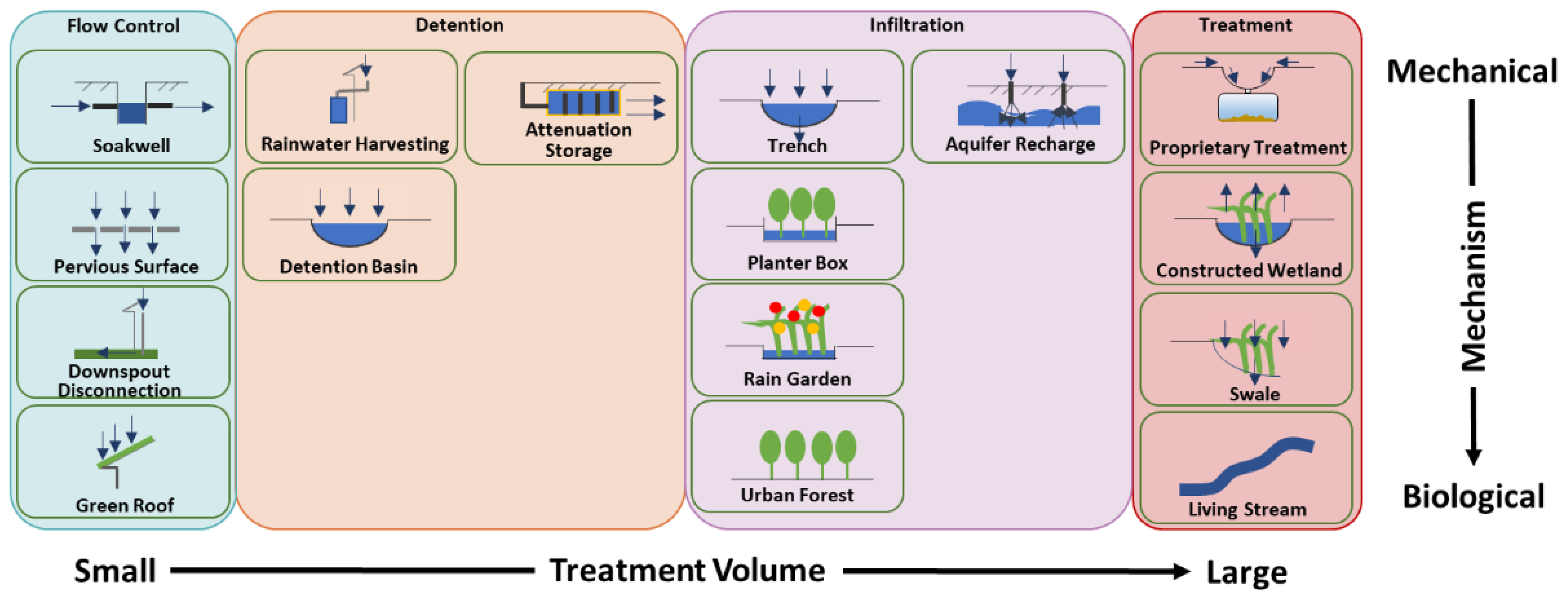


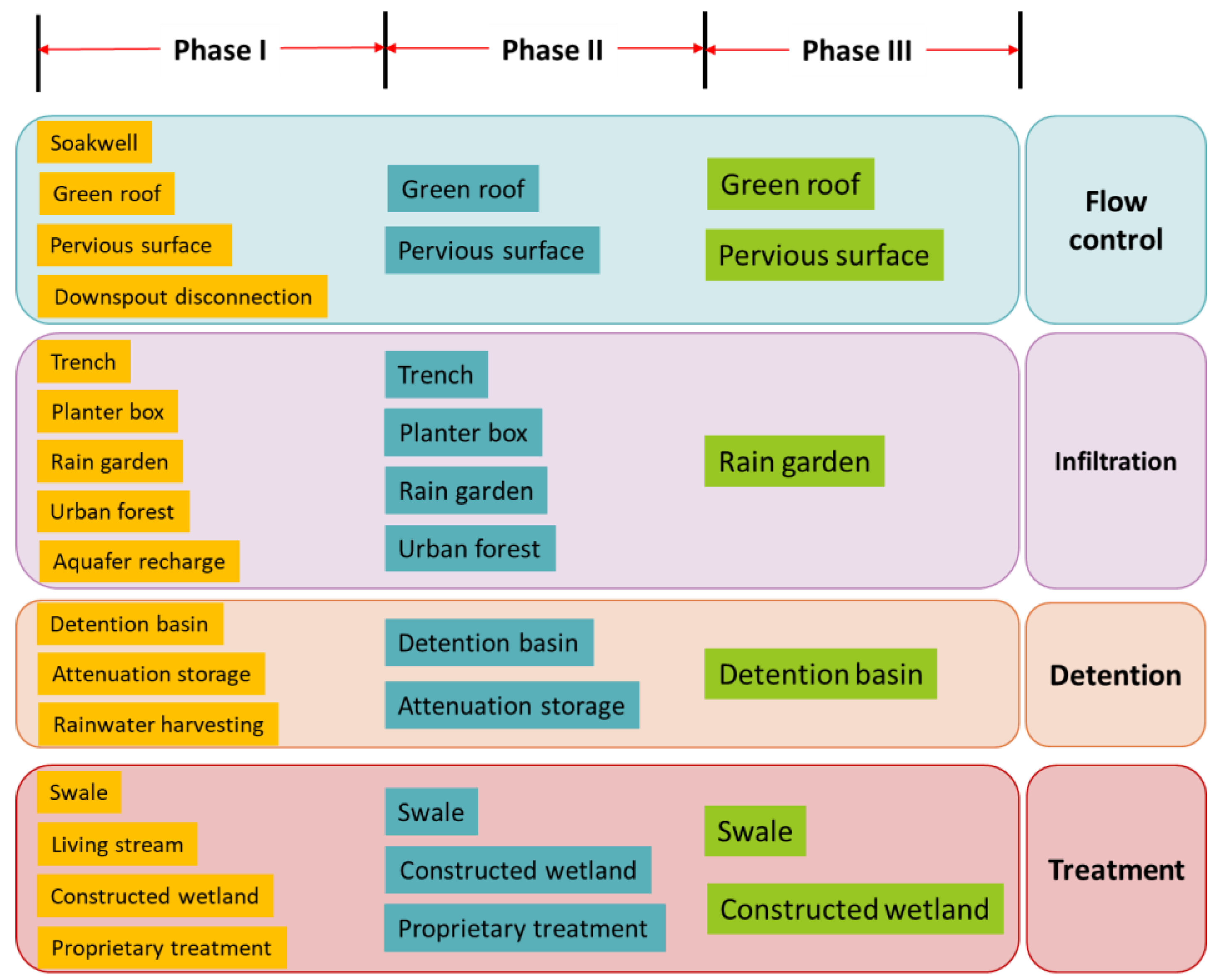
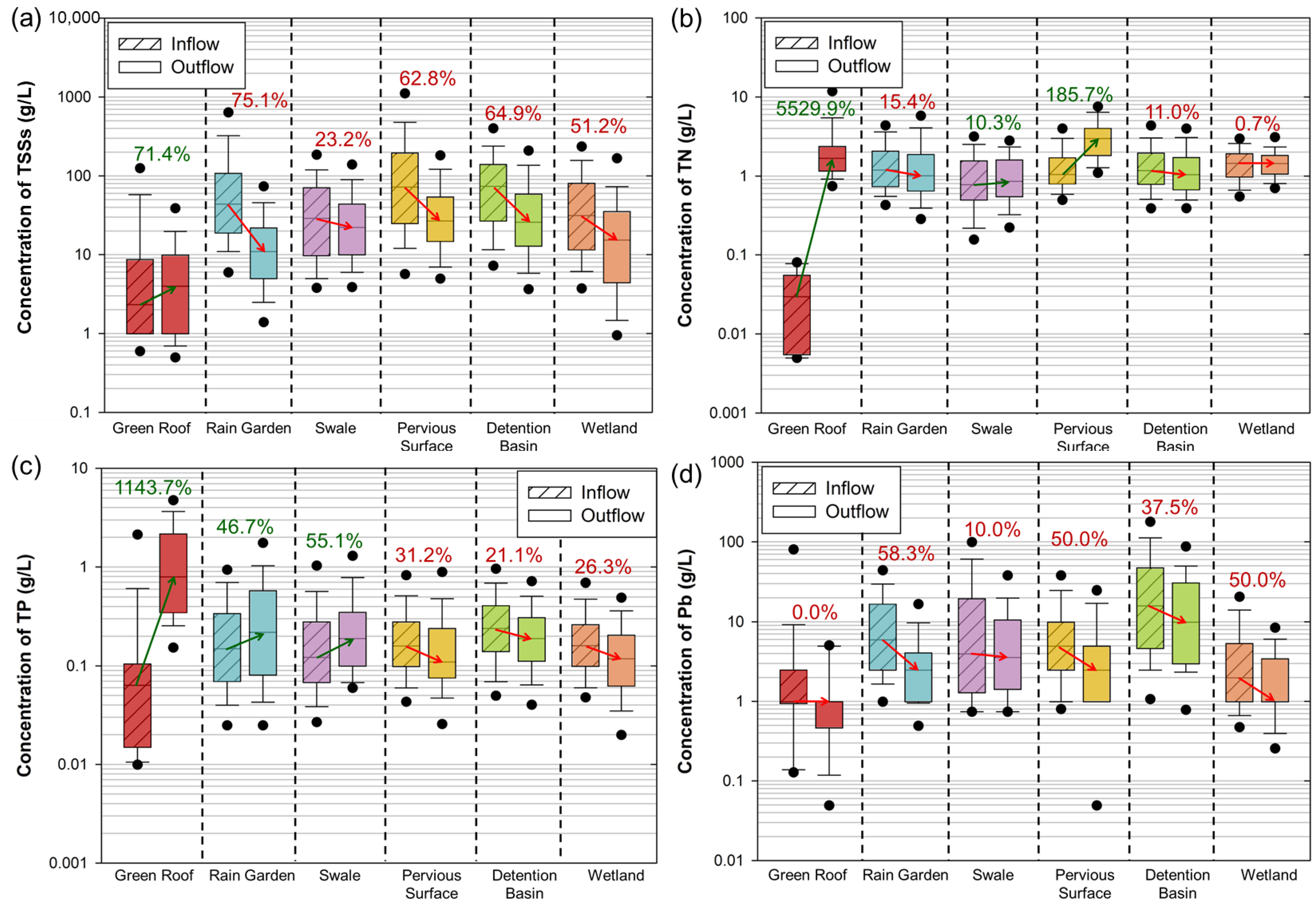
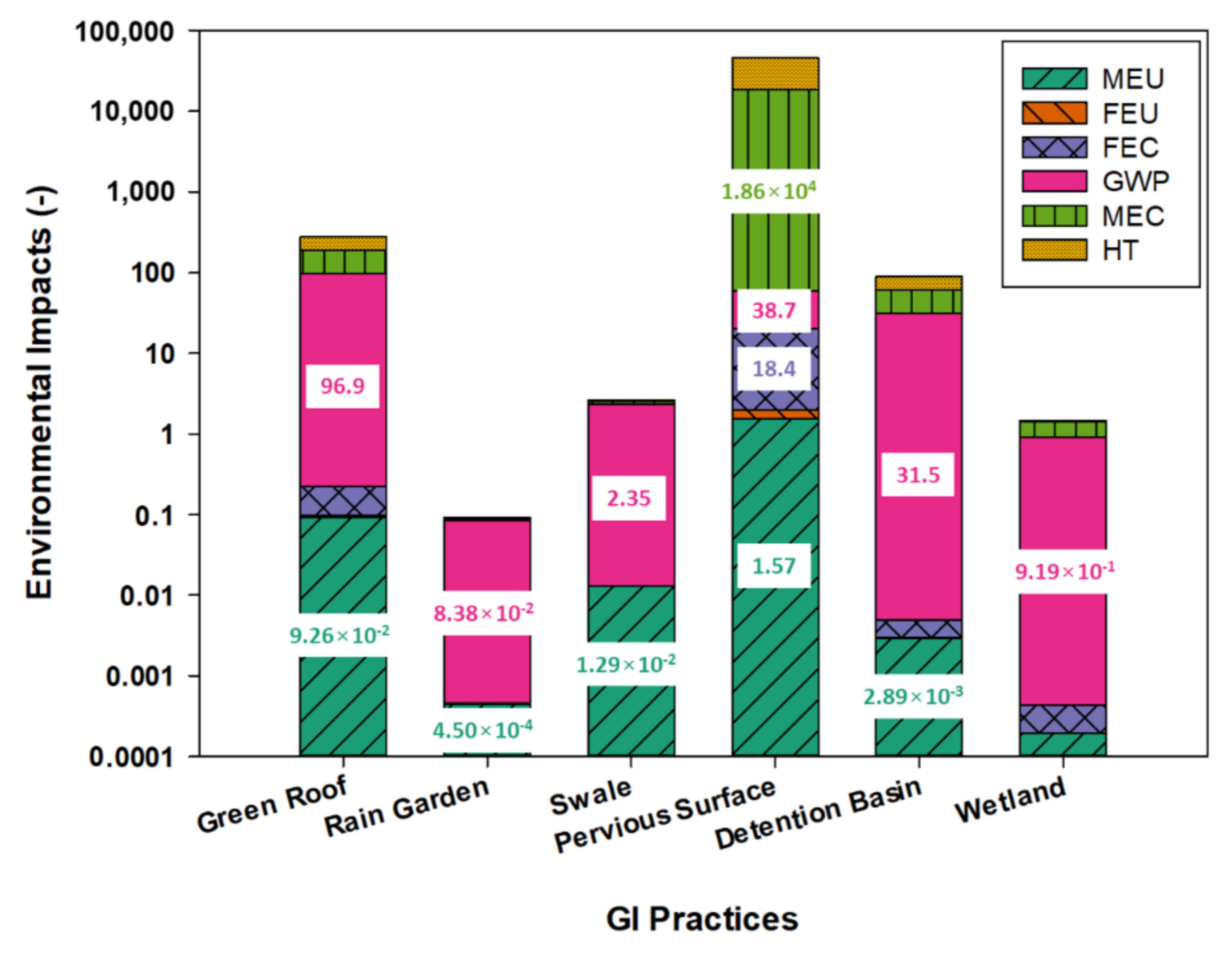
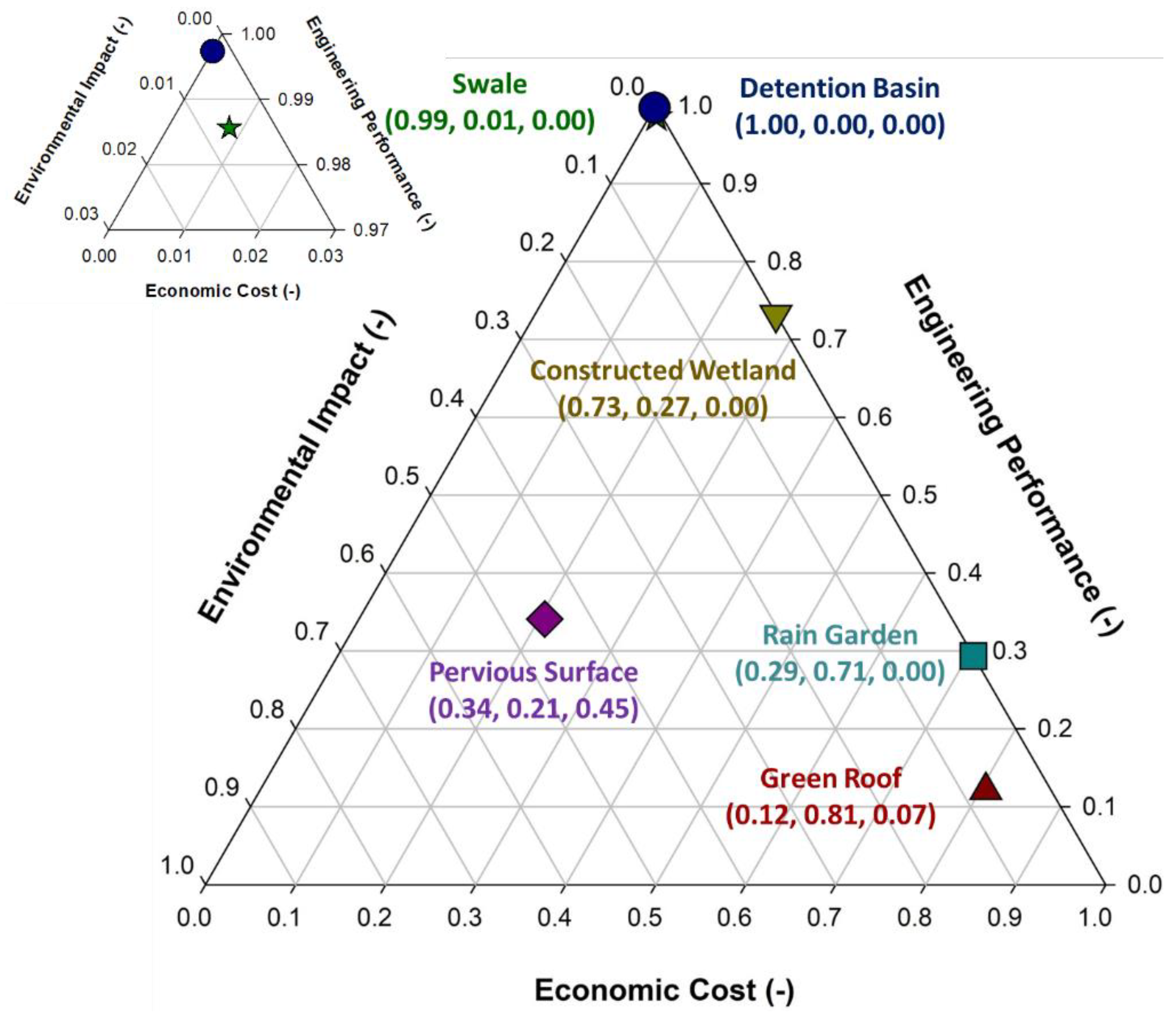

| Aspects | Key Performance Indicators | Units | Wi | Remarks | |
|---|---|---|---|---|---|
| Engineering performance (EP) | EP1 | Peak flow reduction | % | 0.40 | Related to technological risk |
| EP2 | Peak flow delay | hours | 0.20 | Related to commercialization risk | |
| EP3 | TSSs reduction | % | 0.10 | Related to technological risk | |
| EP4 | TN reduction | % | 0.10 | Related to technological risk | |
| EP5 | TP reduction | % | 0.10 | Related to technological risk | |
| EP6 | Lead reduction | % | 0.10 | Related to technological risk | |
| Life cycle environmental impact (LCEI) | LCEI1 | Global warming potential | kg CO2-Eq | 0.05 | Related to ecosystem risk |
| LCEI2 | Freshwater ecotoxicity | kg 1,4-DCB | 0.10 | Related to ecosystem risk | |
| LCEI3 | Freshwater eutrophication | kg P-Eq | 0.20 | Related to ecosystem risk | |
| LCEI4 | Human toxicity | kg 1,4-DCB | 0.35 | Related to human health risk | |
| LCEI5 | Marine ecotoxicity | kg 1,4-DCB | 0.10 | Related to ecosystem risk | |
| LCEI6 | Marine eutrophication | kg N-Eq | 0.20 | Related to ecosystem risk | |
| Economic cost (EC) | EC1 | Construction cost | USD/m2 | 0.70 | Related to economic risk |
| EC2 | Operation and maintenance cost | USD/m2 | 0.30 | Related to regulation risk | |
| Pollutant | Mechanism | Description | Ref. |
|---|---|---|---|
| Solid | Sedimentation and filtration | GIs can provide extended hydraulic retention time, facilitating the sedimentation process. | - |
| Nitrogen | Volatilization | [47] | |
| Nitrification | [48] | ||
| Denitrification | [49] | ||
| Phosphorous | Adsorption and Reduction | The process is controlled by pH, redox potential, and mineral compositions. | [50] |
| Metals | Adsorption and cation exchange | Interaction with the soil matrix. | - |
| Microbial degradation | Metal could be oxidized in aerobic zones and/or be transformed to sulfides in anaerobic zones, both leading to facilitated precipitation. | [51] | |
| Plant uptake | Soluble metals could be absorbed by plants and most of them accumulate in the roots. | [49] |
| Green Infrastructure Practices | Construction | References | ||
|---|---|---|---|---|
| Materials | Processing | |||
| 1 | Green roof | Polyethylene: 0.46 kg/m2 Polypropylene: 14.25 kg/m2 PVC: 9.50 kg/m2 | Material production | [52] |
| 2 | Rain garden | Sand: 58.58 kg/m2 Clay: 37.59 kg/m2 Gravel: 185.53 kg/m2 | Material production Excavation: 0.26 m3 | [53] |
| 3 | Swale | Clay: 1079.18 kg/m2 | Material production Excavation: 0.61 m3 | |
| 4 | Pervious surface | Cement: 281.91 kg/m2 Gravel: 281.91 kg/m2 | Material production Excavation: 0.15 m3 | |
| 5 | Detention basin | HDPE: 0.46 kg/m2 Peat: 75.29 kg/m2 Sand: 976.58 kg/m2 PVC: 0.30 kg/m2 | Material production Excavation: 1.22 m3 | |
| 6 | Constructed wetland | Steel: 2.94 kg/m2 PVC: 2.11 kg/m2 Gravel: 719 kg/m2 | Material production Excavation: 0.35 m3 | [54] |
| GI Instrument | Green Roof | Rain Garden | Swale | Pervious Surface | Detention Basin | Wetland | |
|---|---|---|---|---|---|---|---|
| Engineering Performance | Peak Flow Reduction (%) | 64.5 ± 21.4 [56,57,58] | 52.5 ± 14.8 [59,60] | 60.5 [61,62] | 86 [63] | 96.5 [64] | >80 [65] |
| Peak Flow Delay (h) | 0.5 [56,66] | 1.5–3.0 [59,60] | 0.7 [67] | 1 [63,68] | 9.8 [69] | 48–72 [65,70] | |
| TSS Removal (%) | −71.4 | 75.1 | 62.8 | 23.2 | 64.9 | 51.2 | |
| TN Removal (%) | −5529.9 | 15.4 | −185.7 | −10.3 | 11.0 | 0.7 | |
| TP Removal (%) | −1143.7 | −46.7 | 31.2 | −55.1 | 21.1 | 26.3 | |
| Lead Removal (%) | 0.0 | 58.3 | 50.0 | 10.0 | 37.5 | 50.0 | |
| Environmental Impact | GWP | 96.9 | 8.38 × 10−2 | 2.35 | 38.7 | 31.5 | 9.19 × 10−1 |
| FEC | 1.27 × 10−1 | 6.06 × 10−6 | 6.97 × 10−5 | 18.4 | 1.92 × 10−3 | 2.46 × 10−4 | |
| FEU | 3.72 × 10−3 | 6.80 × 10−9 | 1.95 × 10−7 | 4.34 × 10−1 | 9.85 × 10−5 | 4.64 × 10−8 | |
| HT | 88.6 | 2.70 × 10−3 | 7.62 × 10−2 | 2.71 × 104 | 28.0 | 4.48 × 10−2 | |
| MEC | 92.3 | 5.37 × 10−3 | 1.52 × 10−1 | 1.86 × 104 | 29.2 | 5.23 × 10−1 | |
| MEU | 9.26 × 10−2 | 4.50 × 10−4 | 1.29 × 10−2 | 1.57 | 2.89 × 10−3 | 1.95 × 10−4 | |
| Economic Cost | Capital Cost (USD/m2) | 106 | 120 | 1.00 | 60.00 | 1.01 | 1.20 |
| Maintenance Cost (USD/m2) | 3.14 | 7.20 | 0.31 | 0.33 | 0.21 | 8.38 | |
Publisher’s Note: MDPI stays neutral with regard to jurisdictional claims in published maps and institutional affiliations. |
© 2021 by the authors. Licensee MDPI, Basel, Switzerland. This article is an open access article distributed under the terms and conditions of the Creative Commons Attribution (CC BY) license (https://creativecommons.org/licenses/by/4.0/).
Share and Cite
Xing, Y.-J.; Chen, T.-L.; Gao, M.-Y.; Pei, S.-L.; Pan, W.-B.; Chiang, P.-C. Comprehensive Performance Evaluation of Green Infrastructure Practices for Urban Watersheds Using an Engineering–Environmental–Economic (3E) Model. Sustainability 2021, 13, 4678. https://doi.org/10.3390/su13094678
Xing Y-J, Chen T-L, Gao M-Y, Pei S-L, Pan W-B, Chiang P-C. Comprehensive Performance Evaluation of Green Infrastructure Practices for Urban Watersheds Using an Engineering–Environmental–Economic (3E) Model. Sustainability. 2021; 13(9):4678. https://doi.org/10.3390/su13094678
Chicago/Turabian StyleXing, Yi-Jia, Tse-Lun Chen, Meng-Yao Gao, Si-Lu Pei, Wei-Bin Pan, and Pen-Chi Chiang. 2021. "Comprehensive Performance Evaluation of Green Infrastructure Practices for Urban Watersheds Using an Engineering–Environmental–Economic (3E) Model" Sustainability 13, no. 9: 4678. https://doi.org/10.3390/su13094678







